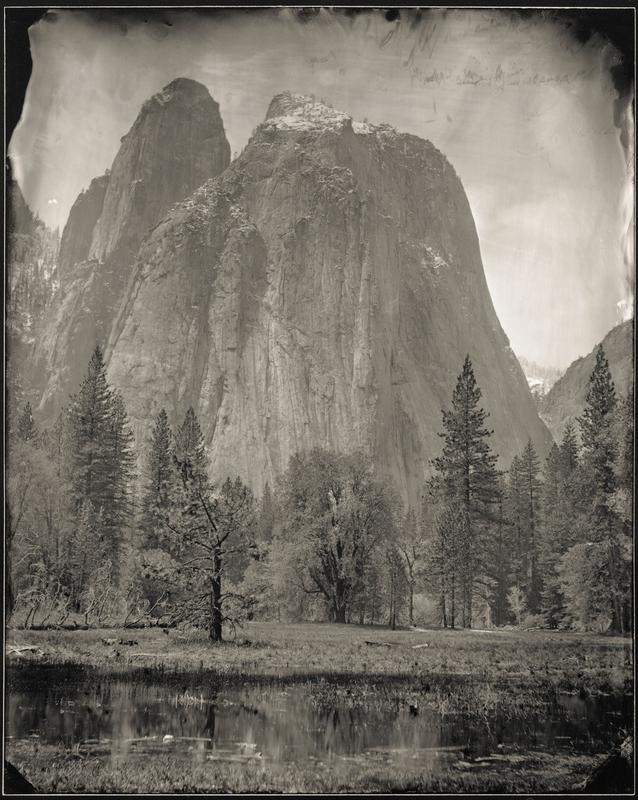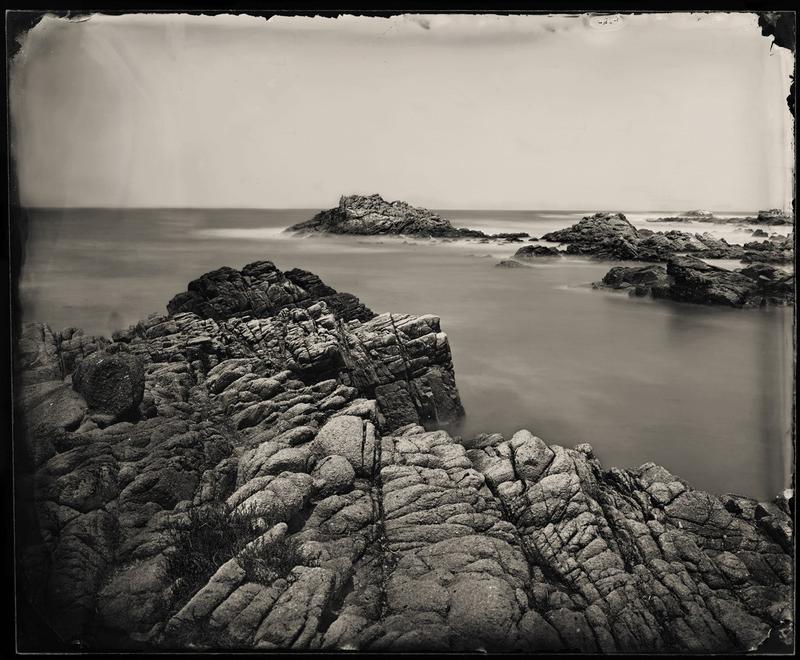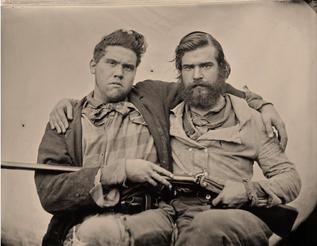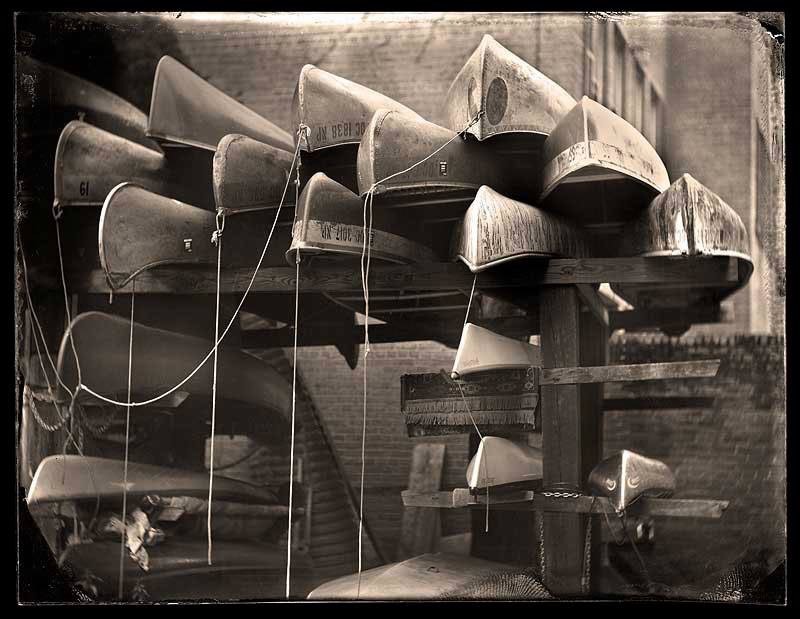COURSE DESCRIPTION
Students will learn the making of ambrotypes (glass direct positives) and tintypes. (tin plate direct positives). Students are guided through the process step-by-step from the mixing, pouring, exposing and development of plates poured with wet collodion. The newest edition of the manual, "MAKING THE WET COLLODION PLATE IN 16 STEPS MANUAL" by Will Dunniway is included along with the course fee from the Photographers' Formulary. This manual is your syllabus for this
workshop.
Students will use original period 1860 field cameras with 1860-70 lenses. This Wet Plate Collodion Workshop features 5 days of intensive hands-on training in the making of ambrotypes, ferrotypes (tintypes), and glass plate negatives. Each student will make and take home a self-portrait/still life tintype/ambrotype.
We will begin with the basics in wet plate collodion, so no experience is required to take our course. One day during the workshop each of you will be given a Brownie type box camera converted to make tintypes. You will make your first tintypes with these cameras. After this lesson you can opt to buy these trick Meniscus lens ‘tintype’ box cameras at $40.
Both instructors are masters of this process with nearly 50 years of combined experience. A rare opportunity to learn from
them.
ABOUT THE INSTRUCTORS
WILL DUNNIWAY
Reviving history through tintype photography. There aren’t many who find their passion later in life and then spend most of their waking hours pursuing it,Will Dunniway is one of those lucky few.
A history buff, Dunniway, now 73, had long been enthralled with 19th century tintypes, a type of early photography he’d only read about and seen in Civil War books as a child. In 1988, he ran across contemporary tintype photographers John Coffer and Claude Levet (RIP) at a Civil War reenactment, Will felt he’d found the keys to the kingdom. . . “My mother used to get me history and Civil War books so I could look at the photography,” said Dunniway, “I’d always wanted to do it myself, but I didn’t know how. When I found someone doing it, it was love at first sight.” Born and raised in Colton, California, Will spent 30 years as a graphic artist in the Santa Cruz Mountains. After retiring in
2003 and moving back to Southern California, Will with his wife Frances, continued to practice and teach the process on location sites and from their studio/home darkroom. Now they live in the Southern Yosemite Gold Rush Hills in California. Will has 30 years practicing the trade.
Dunniway began his correspondence apprenticeship with Coffer by hand-written letter. With Coffer having no phone, the only way they could speak was when Coffer called Dunniway collect from the local hardware store’s pay phone to discuss Dunniway’s most recent collodion mishaps and images. After a year of learning this way, Dunniway reached Coffer’s former apprentice, Claude Levet in Virginia.
Claude picked up where Coffer left off. Will and Claude became inseparable partners in the business of collodion photography at re-enactments, sharing stories and field tips.
Dunniway continued his field collodion work making and selling tintypes and ambrotypes of re-enactors at various historical events — from re-enactments of the 1850 Gold Rush, the 1870’s Old West to the Civil War. After 20 years in the field, and since leaving historical re-enacting in 2009 Dunniway now offers hands-on training and workshops, teaching and assisting by phone any collodion photographer in the field who faces problems with the wet plate process.
Today, Dunniway (www.collodion-artist.com [1]) uses the wet plate collodion process for his 19th century lens study and to make glass negative portraits and landscapes at various parks and locations across America.
Keeping the historical process in the forefront, Dunniway uses only original equipment, choosing from one of his many original wet-plate cameras and an array of original lenses, which are all handmade with hand-ground glass, giving the wet images the soft, unique and different look than you see with modern optics. These old optics tend to have what is called a “sweet spot” in the center of the image and as these images radiate outward, the sharpness falls off. Working in the field and using divine light the result is delightfully ethereal, dreamlike in appearance.
Dunniway is enamored as much with the look and artistic aspect of collodion photography as by the practice itself. Often heard him describe as “painting with light,” Dunniway is committed to replicating as faithfully as possible. “I’m not a carnival photographer,” he said. “I don’t dress people up”. He continues “I’m interested in history, and I wanted to master the process as the early photographers had. Now, when I read about the early photographers and their problems with dirt, dust, rain or bad chemistry, I understand exactly what they are talking about because, even though I was born later, I have become one of them. This is a perfect combination of history and art; the perfect interplay between the past, present and future; between old glass, wood, chemicals and the weather; between luck and sweat,” said Dunniway.“It’s what makes me who I am. When I found collodion photography, I knew I had found what I wanted to do with the rest of my life.”
BOB SZABO
Robert J. Szabo has been a photographer for more than 40 years. His love of history first brought him to Virginia from his native state of Ohio.
After several years of involvement with living history groups, he learned how to make a wet plate collodion plate with the tutoring of John Coffer. From there he relied on his own past as a commercial and portrait photographer and embraced the history of photography.
He is now immersed in the almost forgotten collodion wet-plate photographic process introduced in 1851. His skill produces modern artistic images using 19th century methods. Robert’s artistic vision enables him to peer through his camera and see a window to the past.
Whether an historic scene or a modern image, his work evokes romanticism, yet rests on a sense of strength and stamina. The merging of times seems complete.
Robert has exhibited extensively at historic sites across Virginia, Maryland, Pennsylvania, and other sites from Maryland to California with the National Park Service. He has displayed his work for private historical associations in Virginia such as the John Singleton Mosby Heritage Area Foundation, Middleburg Beautification & Preservation, Inc., Aldie Mill, the Waterford Foundation, and Historic Sandusky in Lynchburg. He has lectured for The Handley Library, Winchester VA; The Yosemite Foundation, Yosemite CA; and the Lincoln Cottage, Washington DC.
In April of 2005, one of Robert’s wet plate images appeared on the cover of National Geographic. Also in 2005, Robert worked with History Channel on the Emmy Award winning series “10 Days that Changed America”, and in August of that year, he shot the entire 2006 Jack Daniel’s Squires Calendar on location in Lynchburg, Tennessee using the wet plate process. In April of 2011, Robert traveled to New York City for a wet plate photo shoot with actor/director Robert Redford. A portrait from that shoot was featured on the cover of Parade Magazine later that month.
Robert recently spent a few years in Kansas City, Missouri, where he was involved with several projects. His work has appeared in the documentary “Bad Blood”, a co-production of KCPT Kansas City Public Television and Wide Awake Films, which aired on March 1, 2011. Bob now lives in Virginia.
Workshop Fee:
$1,050.00
(does not include food & lodging)
Save up to 25% off tuition with a combination of any 2 of the following discounts:
Early Bird Discount:
An early registration by the
TBA
qualifies for a 15% discount on your workshop tuition.
Back to Back Discount:
Register and attend two classes consecutively and receive a 10% discount off the second weeks tuition
Bring a Friend Discount 10% off available when you both sign up for the same workshop.
Basic Wet Plate Collodion
with Will Dunniway & Bob Szabo
August 15-19, 2021
Registration Deadline: July 15, 2021
Will Dunniway
Will Dunniway
Bob Szabo
Bob Szabo



